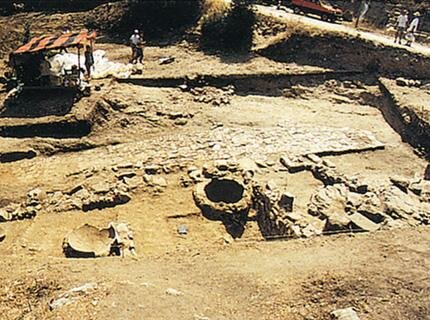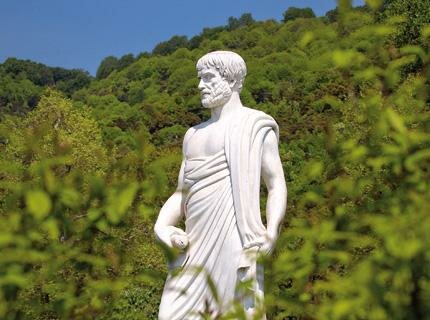⇠ Thessaloniki 108km ⇠ Polygyros 52km
Stagira is a Greek village situated at the foot of the Argirolofos hill. The village stands approximately 8km southwest of the ancient Stagira, the birthplace of Aristotle. The village’s former name was Sidirokafsia and dates back from the Byzantine Era. The area is mentioned already in the beginning of the 10th century AC, when the mines were in full operation. Later on, monasteries from Mount Athos took over their management. From the 15th century and through all the years of the Ottoman Occupation, the mining and elaboration of the minerals became more intense, mainly when the village was under the control of Madem Agas. In the 16th century a castle was built, of which there are still remainders to be seen. During mint century the village also had its own mint.
Sightseeing
• Aristotle’s park. The Theme park is located in a most beautiful area with a marvellous view towards the gulf of Ierissos and the whole peninsula of Athos. When the weather is good you can see some of the monasteries on Mount Athos using a telescope. It also includes a series of other instruments which when used properly will show the phenomena of nature. All of this is dedicated to the famous philosopher and his work called “the Natural”. The instruments include a prism, optical discs, sounding bars, a compass, sundial and pendulum – all illustrating important phenomena studied by the great philosopher.
• The fortress complex, of which only three partly ruined towers exist today as well as the ruins of the public bath that Ishak Pasha constructed in the 15th century.
• The central temple dedicated to the “Birthday of the Virgin Mary”, built in 1814. Also interesting is the small chapel dedicated to the “Virgin Mary the Spilotissa” built in rock.
• The ruins of Sidirocaussia. Many ruins exist around the hill of St. Demetrios (the site of the bath).
✓ can’t miss this!
Walk in the evergreen paths and admire a panoramic view.
More about Ancient town Stagira
The birthplace of the philosopher Aristotle was a colony of Andros, founded in 655 B.C. The first name of the city was Orthagoria. Ally, initially of the Athenians and later of the Spartans, the city was occupied by Philippos in 349 B.C., after the destruction of Olynthos. Philippos, however, rebuilt the city in order to honour the great philosopher, tutor of Alexander the Great. When Aristotle died, his fellow-citizens transported his bones to Stagira and set up a monument. The excavations in the region began in 1990. The most impressive piece that was brought to light is the wall, at the top of the hill that was built in the classic years. The different ways of construction can be distinguished. The wall determines the western limits of the ancient city, surrounded by the sea. The powerful fortification supplemented round and square towers and ramparts that connected with heavy scales. At the top of the hill also appears the relic of the citadel. At the part behind, between the hills, is the well-maintained remainder from some beautiful, spacious public building, with a gallery and a monumental facade with pillars.
Aristotle (384 BC – 322 BC) was born in Stagira. He was a Greek philosopher and polymath, a student of Platon and teacher of Alexander the Great. He is one of the most important founding figures in Western philosophy. Aristotle’s writings were the first to create a comprehensive system of Western philosophy, encompassing morality and aesthetics, logic and science, politics and metaphysics. Aristotle was appointed as the head of the royal academy of Macedon. During that time he gave lessons not only to Alexander, but also to two other future kings: Ptolemy and Kassander.
More about Aristotle’s park
Aristotle’s park is located in Stagira. The Theme park includes a series of other instruments which when used properly will show the phenomena of nature such as: Solar, Lens, Pentaphone, Optical Discs, Pendulum, Water turbine, Inertia spheres, Parabolic reflectors and Telescopes. Aristotle’s Park is an excellent place to learn about activities and interactive games. When the weather is good, you are able to see some of the monasteries on Mouth Athos, using the telescopes.






